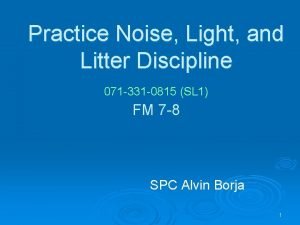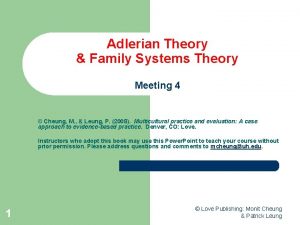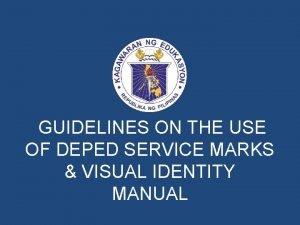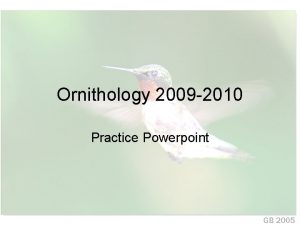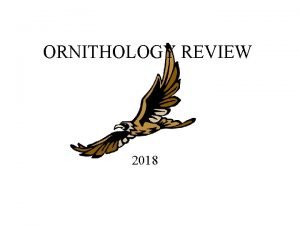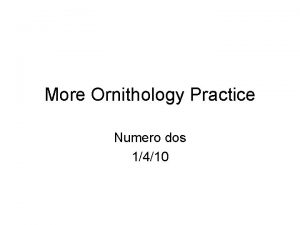Ornithology 2009 2010 Practice Powerpoint Order family common

















- Slides: 17

Ornithology 2009 -2010 Practice Powerpoint

• Order, family, common name/species • How does the male attract females or establish territory? • Describe its habitat.

• Order, family, common name/species • Describe this bird’s habitat. • What type of feet does this bird have?

A C D B • Identify the largest native North American bird. • Give its family, order, and common name. • What does its call sound like?

• Order, family, common name/species • What does this bird eat? What are some adaptations that can tell you this? • Where does this bird nest? What color are its eggs?

• Order, family, common name/species • What unique substance do members of this order ingest and feed to their young? • What characteristic does the genus name represent? (It makes the bird awkward on land) • Bonus: What sort of plant is the one in the left picture in?

• Give the order and family name of both birds. • Which bird is more common, especially in the Southern US? Give its common name. • When does the bird on the left hunt? How does it locate its prey? • What adaptations allow the bird on the left to exhibit the behavior in the above questions?

• Order, family, common name/species • What does this bird eat? • How does it get food?

A • What is the common name of Bird A? • What does Bird A’s call sound like? • What is Bird B’s range? B

• Order, family, common name/species • What behavior does this bird exhibit that is likened to piracy? • What is special about the male’s reddish patch?

B A • Which of the birds does not belong to the same order as the others? To which order does the oddball belong? • To which family does E belong? C D • What gives A its common name? • What gives E its common name? E • How does B react when approached?

• Order, family, common name/species (Not a Stantiozand) • What gives this bird its common name? • What do its eggs look like? What does its nest look like?

• Order, family, common name/species • Where does this bird nest? • What type of feet does this bird have? How do you know?

• Order, family, common name/species • When can the bird reach maximum speed? What is significant about this speed? • This bird gained endangered species status after what? What biological phenomenon led to this problem? • Where does this bird nest?

• Order, family, common name/species • Where is this bird found? • Describe this family’s flight.

A B • Order, family, common name/species of both birds • Describe bird A’s bill shape. What does this tell you about its diet? • Describe bird A’s flight pattern. • What does bird B’s song sound like?

• Order, family, common name/species • In which US state(s) is this bird found? • What does this bird eat? What adaptations does it have to suit its lifestyle?
 Ornithology science olympiad
Ornithology science olympiad Calendario escolar 2009 a 2010 sep
Calendario escolar 2009 a 2010 sep Via optica
Via optica Powerpoint zemin rengi
Powerpoint zemin rengi Cara mengoperasikan ms power point
Cara mengoperasikan ms power point Format painter powerpoint
Format painter powerpoint San diego regional science olympiad
San diego regional science olympiad Ornithology science olympiad cheat sheet
Ornithology science olympiad cheat sheet Pharmacy order 2010
Pharmacy order 2010 Common factors of 12 and 24
Common factors of 12 and 24 Is cereal a common noun or proper noun
Is cereal a common noun or proper noun Practice noise light and litter discipline cit
Practice noise light and litter discipline cit Family systems theory powerpoint
Family systems theory powerpoint Department of education service marks
Department of education service marks Lowest common denominator and greatest common factor
Lowest common denominator and greatest common factor Common anode and common cathode
Common anode and common cathode Factor tree for 72
Factor tree for 72 Factors of 54
Factors of 54











